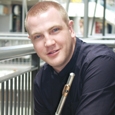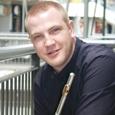Question: I am having a difficult time flutter tonguing. It seems impossible to trill my r’s. Do you have any advice on how to get this started?
Answer: Your question is a very common concern. Flutter tonguing is a technique used by many brass and woodwind instruments that creates a trilling effect in the sound. Tchaikovsky was the first prominent composer to use this sound effect for flute in his ballet The Nutcracker. It is important to note that there are two different ways to create this effect. The standard method is to use the tongue to trill the r like you are speaking Italian. There is also a more guttural approach that uses the glottis to alter the sound. There is a big difference in the quality of sound between the two, and in my experience, the method using the tongue is preferred by most professional players.
There are some genetic conditions that can restrict the movement of the tongue. The most common being ankyloglossia, better known as a tongue-tie. A tongue-tie is a condition present at birth where the lingual frenulum is unusually thick and short. This restricts the movement of the tongue and in severe cases might make it difficult for people to even stick out their tongues. Usually solved by a simple surgery, not all tongue-ties are equal in severity, and some go unnoticed until later in life.
I frequently hear students declare that their mother tongue limits them to a guttural flutter. The “I don’t speak Spanish” defense is another common reaction from students when we start to work on this aspect of articulation in lessons. The good news is that there are some excellent ways to stimulate what is commonly known as an alveolar trill. Through the simple exercise below that was recommended to me by a speech therapist, I have had tremendous success helping students conquer this hurdle. The exercise is by no means a quick fix, but rather a starting point to release the tongue from the dreaded TLLLLL result.
I usually see three ability levels of trilling r’s in students. Some experience no problem at all producing a resonant tone with the alveolar trill. A second group of students can start the flutter but have difficulty sustaining the effect. The last group cannot produce an alveolar trill at all.
If you fall into the second category, my recommendation would be to ensure that the source of the sound comes from a place of warmth and moisture. You have probably heard the analogy of fogging up a mirror with your breath when you produce sound on the flute. I find this to hold true for a successful flutter effect as well.
Players in category two have difficulty sustaining the sound because the throat closes off, the embouchure tightens, and sustaining the alveolar trill becomes close to impossible because the embouchure cannot accommodate the amount of pressure. The muscles simply are not strong enough.
I am fortunate to speak Afrikaans as my mother tongue because it requires me to trill all my r’s. After encountering numerous students with this question, I investigated how I trill my r’s when speaking Afrikaans. I realized that I treat the vowels surrounding the r very differently and place them further back in the mouth than a native English speaker from the United States would. An easy way to explain this is with the word can’t. Pronounce this word with your most convincing American and British accents and notice how the vowel is placed in different locations.
I use the following tongue-twister with my students in lessons to gently guide them away from the guttural flutter. I have had enormous success initiating a healthy flutter in students through carefully working with this exercise. The exercise succeeds because it deals with the onset of the syllables and how the tongue should react right after that.
Lescued Looster Luffles Lesidents
Plescued Plooster Pluffles Plesidents
Blescued Blooster Bluffles Blesidents
Tlescued Tlooster Tluffles Tlesidents
Dlescued Dlooster Dluffles Dlessidents
Rescued Rooster Ruffles Residents
An alveolar trill is apical in nature, meaning the sound is sustained with the tip of the tongue. Often the placement of the tip of the tongue is too far forward in the mouth, causing unwanted jaw tension and an airstream that is aimed much too high. This will result in a flutter tone that is very airy. With every new line of the tongue-twister, the tip of the tongue is guided closer to the alveolar ridge, the area between the upper teeth and hard palate in the mouth.
The first line of the tongue-twister makes you aware of the dental consonant area of your hard palate, a placement too forward to be successful for an alveolar trill. Lines two and three move on to the labial sounds, where the sound is created with the lips. The goal here is to promote relaxation of the tongue. With an alveolar trill the back of tongue is completely relaxed and down so the tip of the tongue trills freely. The words beginning with a P or B sound make the flutist aware of the small difference in jaw placement between the two, with B being optimal for flutter tonguing. The lines beginning with the Tl and Dl sounds start to show the tongue how to react once the onset of the sound has been created inside the mouth. The words beginning with Dl place the tip of the tongue further back in the mouth compared to Tl, making for a more successful alveolar trill.
The last step of the exercise is to joyfully speak the final line of the tongue-twister with flutter tongue, exaggerating the alveolar trills. Go about this with confidence, not only exploring the onset of the sound, but also air pressure, support and continuous flow of air. One of my students started to flutter spontaneously after working on the line that starts with the Bl sound. For her it was placement of the jaw that needed to be adjusted. Once this was taken care of, the flutter tonguing happened by itself.
Although this journey can be frustrating at times, keep your sense of exploration alive while working on this issue. Even though the final goal is to successfully flutter tongue, you might improve many other aspects of your playing if you are open to noticing small subtleties in your sound. This is difficult to achieve if you are working through a lens of frustration.






